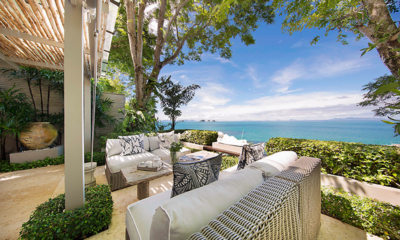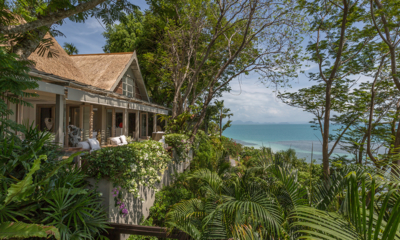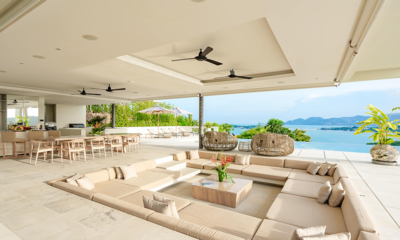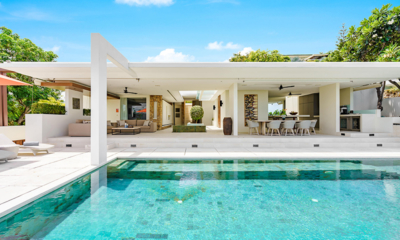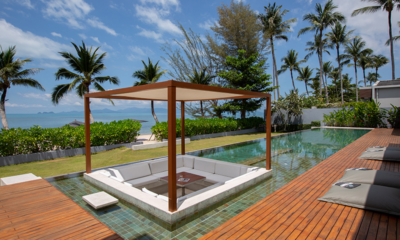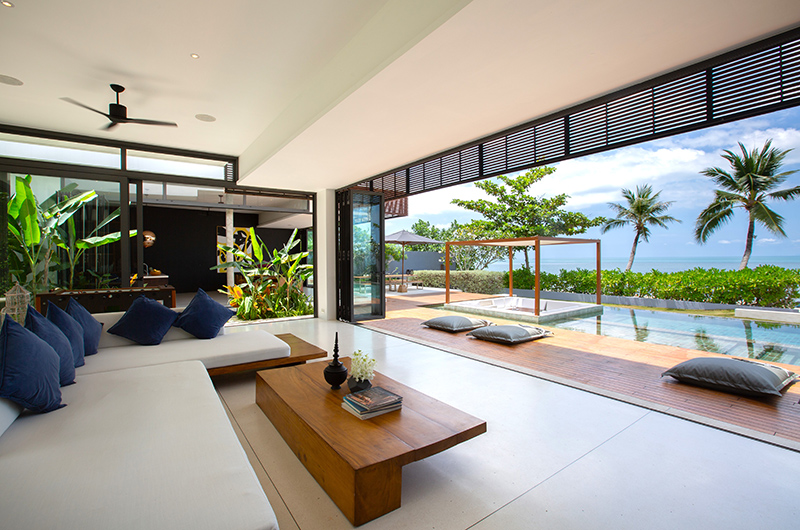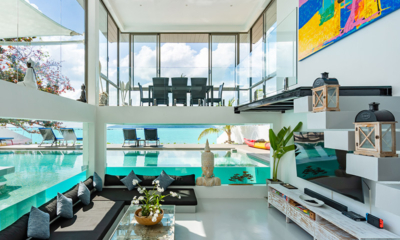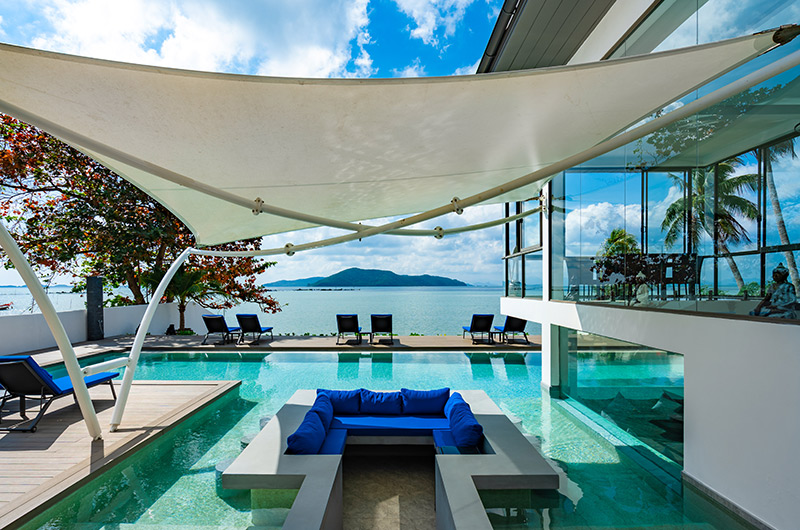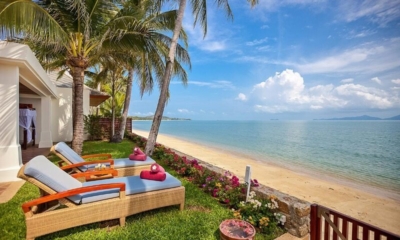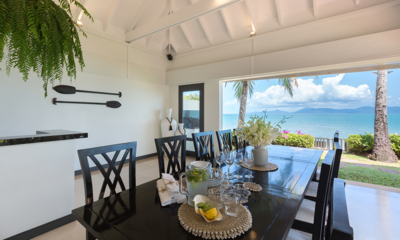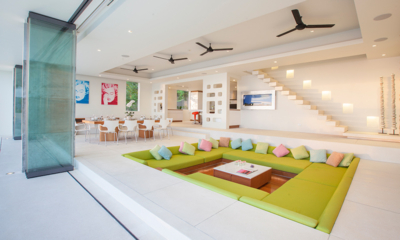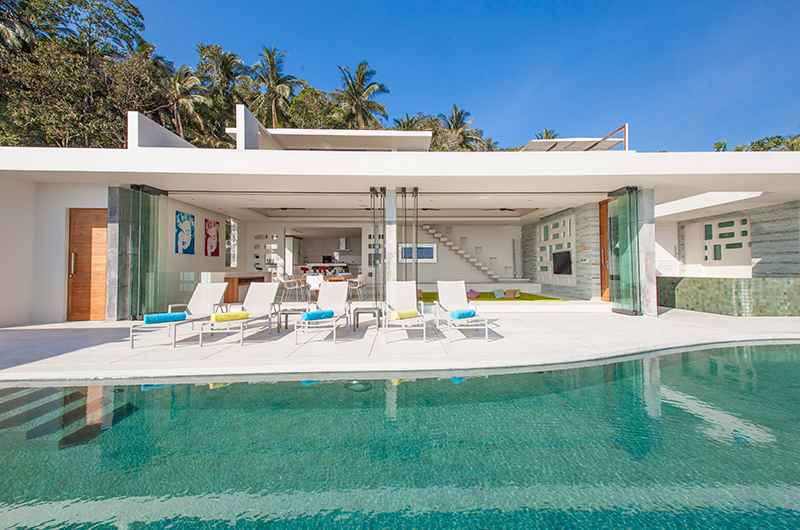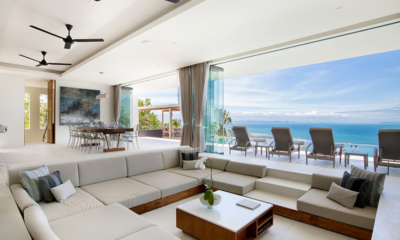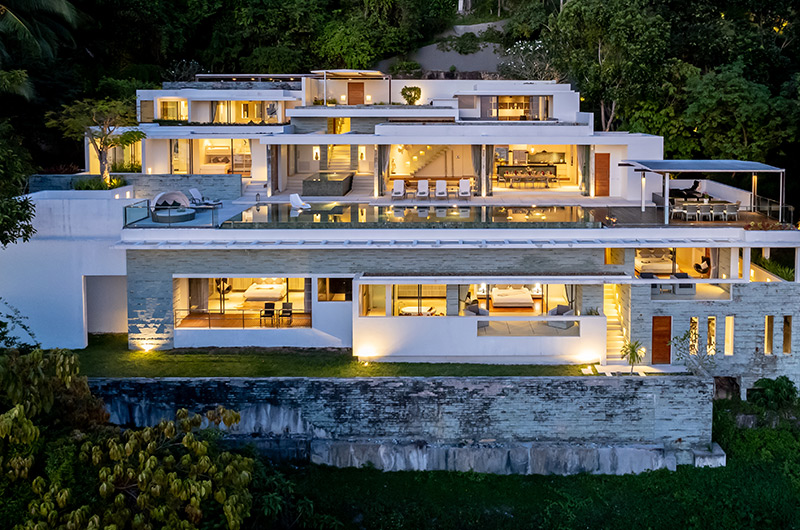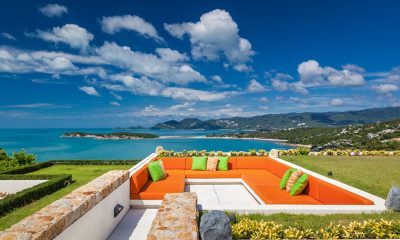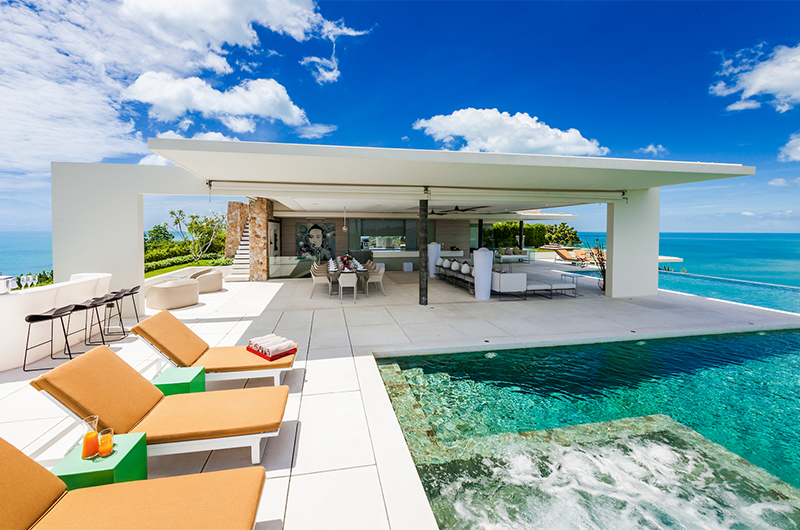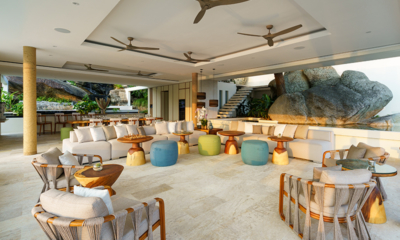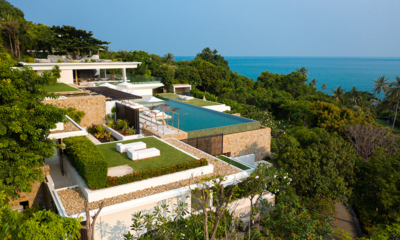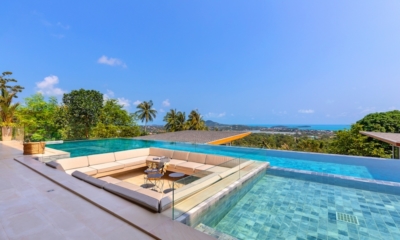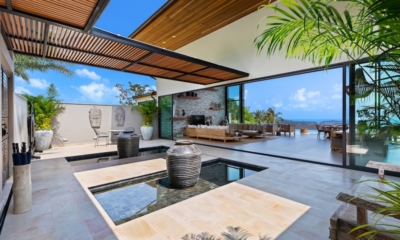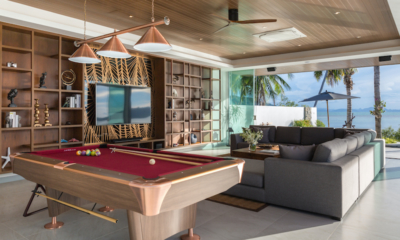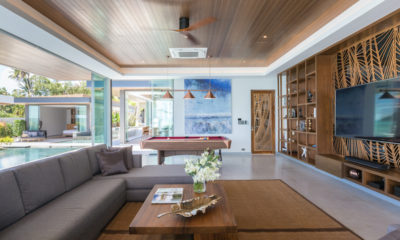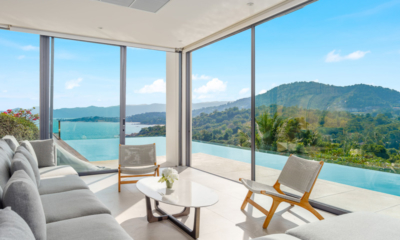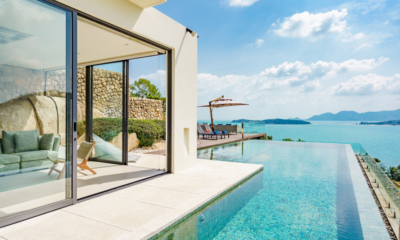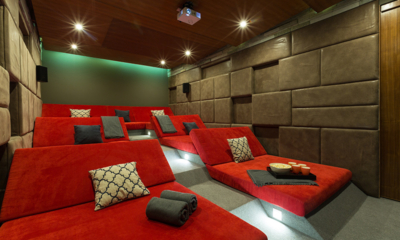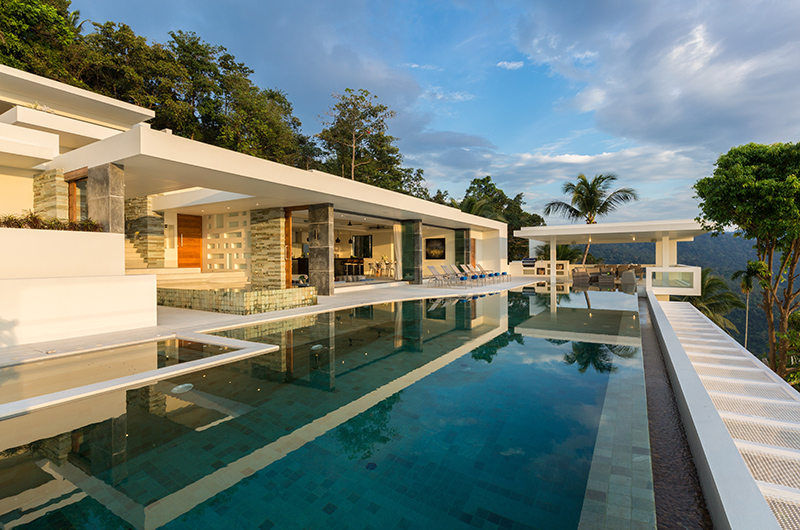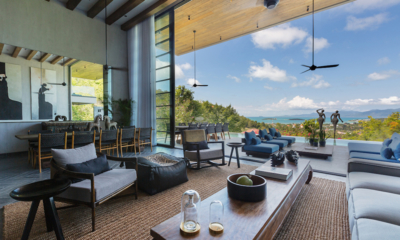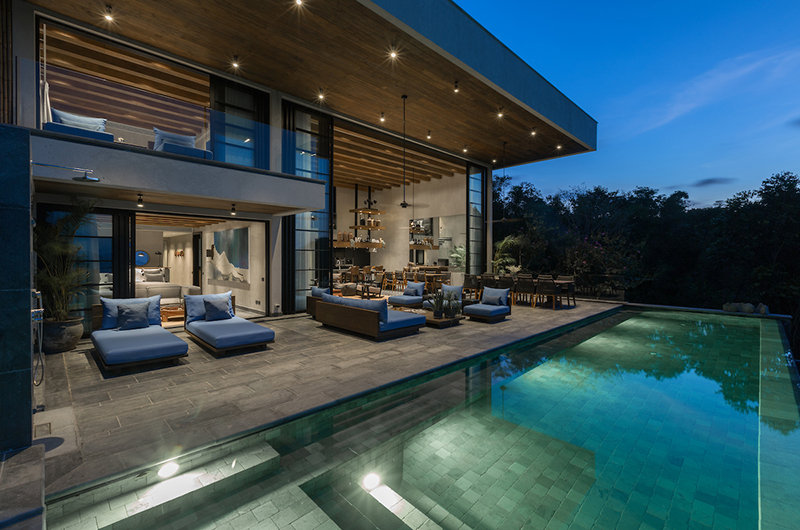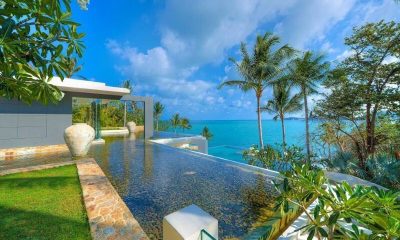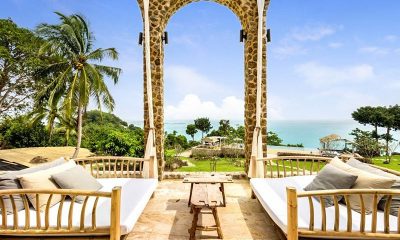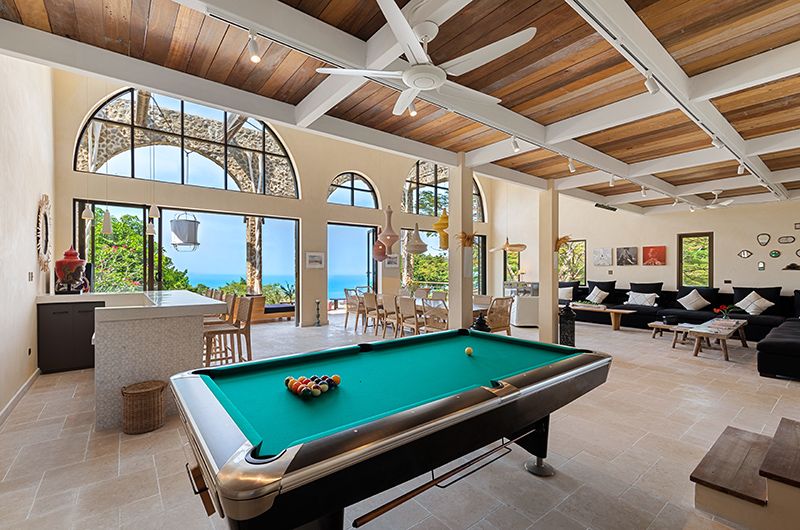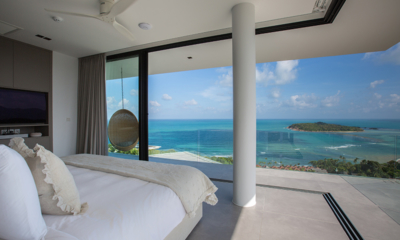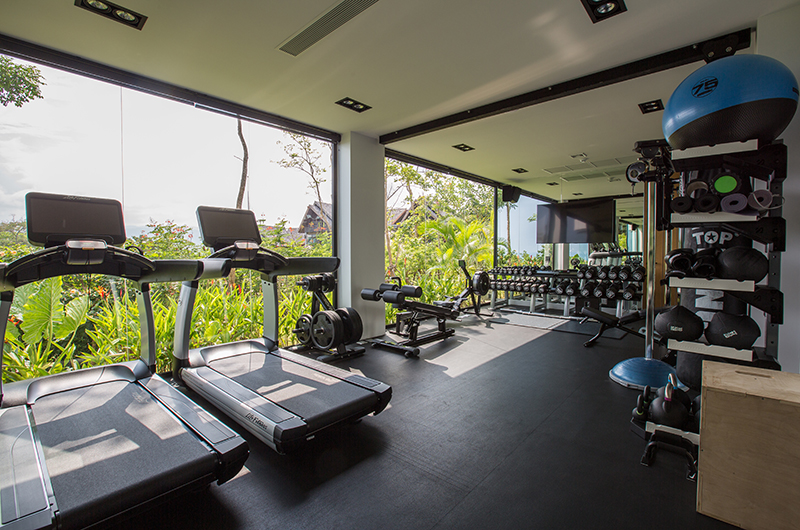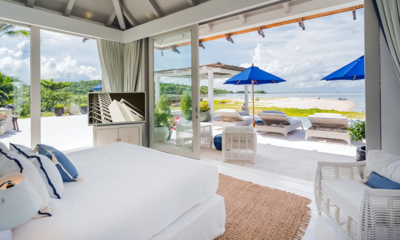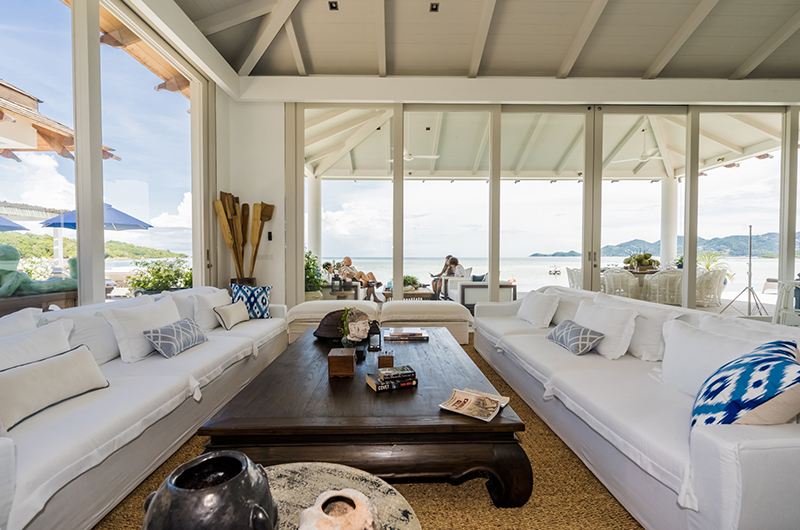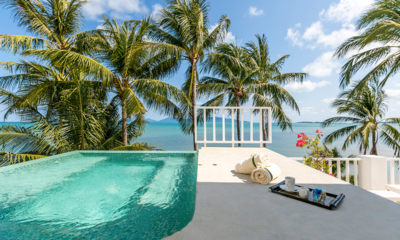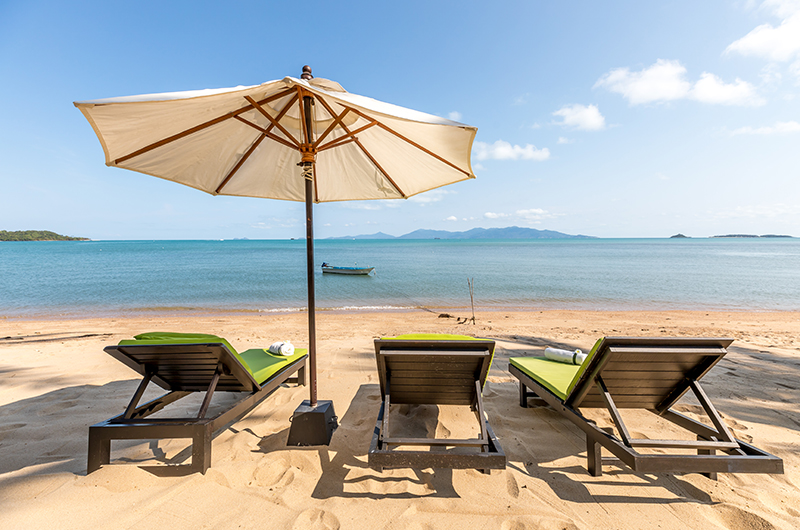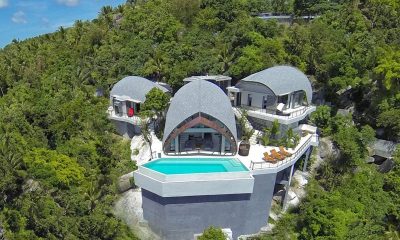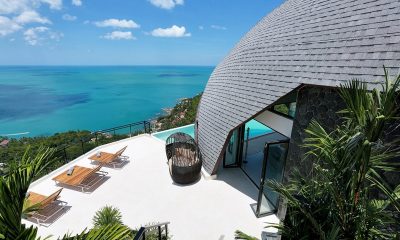With its picture-perfect beaches and aqua blue waters, Koh Samui is primed for that blissful beach holiday you’ve always dreamed of. The Pearl of the Gulf is blessed with soft white sand and dreamy palm trees, with world class spas and amazing beachfront villas ready to wrap you in luxury. This knockout of an island will charm you with its natural beauty and wow you with its gracious hospitality.
Overview
The name Koh Samui has a near magical ring to it. Mere mention of the island evokes images of the ultimate beach escape: White sandy beaches framed by palm trees. Swims in the clear blue ocean. Massages at a five-star spa. A dip in your private pool. Dining by the beach with your toes touching the sand as the sun sinks into the Gulf of Thailand. Though it is a relatively small island – less than half the size of Phuket and just a fraction of the size of Bali – Koh Samui packs a lot of punch, beauty and contrasts into its 228 square kilometres.
Some visitors fall head over heels for the vibrant buzz of Chaweng and Lamai which offer seemingly endless opportunity for wining, dining, shopping and overall merrymaking. Others are partial to the laidback vibe of the northern beaches – don’t miss the relaxed charm of Bophut’s Fisherman’s Village and the gilded elegance of the Big Buddha. Exploring further afield, you’ll discover hidden beaches, wild waterfalls and sweeping lookout points that will take your breath away. Thanks to the compact size of the island, you can easily explore any and every area you wish… or simply stake your claim over a private slice of paradise and stay put.
History & Culture
Long before chic beach clubs and an international airport graced these shores, Koh Samui was a secluded island covered in lush jungle. The island is thought to have welcomed its first inhabitants some 1,500 years ago when fishermen from China and the Malay peninsula landed on its shores. For centuries, Koh Samui remained largely isolated from mainland Thailand. Back in the day, Koh Samui was only accessible by boat and it could take a full day to trek across the island. This all began to change during the 20th century.
The first roads in Koh Samui were built during the 1970s, including the 52-kilometre ring road that circumvents the island. During that same decade, international visitors started discovering Koh Samui. The following years saw local tourism gradually evolve from humble beach shacks to luxury villas and five-star resorts. Things kicked into high gear in 1989 when Samui Airport was officially opened. Today, Koh Samui welcomes over 2 million visitors every year, making it one of the most visited places in Thailand.
Planning Your Trip to Koh Samui
Koh Samui is compact in size and you can circumvent the island in less than 90 minutes. This means you don’t have to worry about missing out or stress over planning the perfect itinerary. In Koh Samui, you can go with the flow and see where the day takes you. You can easily explore different areas of the island and discover a different beach and a new favourite restaurant every day of the week. Alternatively, you can choose your favourite pool, beach or restaurant and simply stay put! Our Koh Samui travel guide aims to give you the essential information, list the most popular things to do in Koh Samui, provide more information on locations you want to visit, and finish with some inspiration from our travel writers.
Koh Samui Weather
Koh Samui is a gorgeous destination any time of year. February and March are usually the sunniest months, while April tends to be the hottest – it’s also when the Songkran water fight festival takes place. Koh Samui is lovely from May until September, though you should expect the occasional shower. The weather starts getting cloudier in September, giving way to the wet season which spans from late October to mid-December. During this period, it tends to rain a lot so if you’re dead set on a blissful beach holiday, it might not be the best time to visit. Heading to Christmas and New Year, the showers are generally fewer and farther between. January bookends the rainy season in Koh Samui and temperature wise, it is usually the coolest month of the year.
Things To See & Do in Koh Samui
Koh Samui is the island destination of your wildest dreams. Surrounded by crystal clear waters dotted with limestone formations, this petite Thai island boasts white sandy beaches, luxe beach clubs, delicious restaurants, gilded temples and so much more. From the lively buzz of Chaweng to the tranquil beaches hidden throughout, Koh Samui is paradise come to life.
Attractions
Koh Samui has become world famous for its stunning white sand beaches. The island also offers beautiful cultural landmarks and lush green landscapes for visitors to explore. Nestled by the clear blue waters of the Gulf of Thailand, Koh Samui is neighboured by the Ang Thong Natural Marine Park and the surrounding waters offer the perfect conditions for world class snorkelling and diving.
CULTURE
Koh Samui offers an enticing fusion of local Thai heritage, deep Buddhist faith and international influences derived from far and wide. Thai people are famous for their hospitality and it’s easy for visitors to feel right at home on this beautiful island. Over 90% of Thailand’s population are Buddhist and you will find beautiful temples and religious monuments dotted across the island. Festivals, religious and otherwise, take place throughout the year. The most famous events are the annual Songkran water fight festival and the monthly full moon parties which take place on neighbouring Koh Phangan.
TEMPLES
Koh Samui’s gilded temples wow with their ambitious architecture, intricate artwork and tranquil atmosphere. Many of the temples are built on hilltops so you’ll also enjoy sweeping views looking over this gorgeous island and out to the ocean. Here are some of the most notable temples in Koh Samui:
- Big Buddha: This 12-metre tall Buddha statue has become Koh Samui’s most prominent landmark.
- Wat Khunaram: This temple is most famous for displaying the mummified body of monk Luong Pordaeng who passed away in 1973.
- Wat Plai Laem: This modern Buddhist temple features a dramatic statue of the Chinese deity Guanyin wielding 18 arms.
- Wat Ratchathammaram: A unique red temple built from red clay, featuring stunningly intricate reliefs.
- Wat Khao Chedi: A serene temple featuring a gilded statue of a reclining Buddha and magnificent views of the neighbouring islands.
- Nathon Hainan Shrine: An ornately decorated Chinese temple dating back to the 19th century
NATIONAL PARKS & NATURE
There’s more to Samui than just its (admittedly gorgeous) beaches! From lush rainforest to untamed waterfalls, there is so much beauty to discover on land – not to mention the wonders waiting underwater and on nearby islands. Here are the most popular national parks and natural landmarks in Koh Samui.
- Ang Thong National Marine Park: An archipelago of some 40 limestone islands offering amazing snorkelling, diving and island hopping.
- Na Muang Waterfalls: The most famous waterfall in Koh Samui cascades down from an 18-metre height.
- Hin Ta & Hin Yai: Known as Grandfather and Grandmother Rock, this famous rock formation is set on a beautiful sandy beach.
- Secret Buddha Garden: This beautiful sculpture park is surrounded by rainforest and features countless Buddha statues, birds and small waterfalls.
Relaxation
With its breathtaking beaches and blissful spas, Koh Samui is the ultimate destination for rest, rejuvenation and sheer unapologetic indulgence. Thanks to its long standing spa culture and thriving yoga scene, Koh Samui is one of the most popular wellness destinations in the world.
BEACHES
Beaches are without a doubt the main event in Koh Samui. Boasting soft sand ranging from a warm golden hue to talcum powder white, Samui’s beaches are the perfect place for recharging your batteries. This idyllic island is blessed with some of the best beaches in Thailand – here are just a few of the most popular options:
- Chaweng: Koh Samui’s most popular beach lined with restaurants, shopping, water sports and nightlife.
- Lamai: The most popular beach after Chaweng, Lamai offers a long stretch of sand, clear waters and plenty of amenities.
- Bophut Beach: A popular beach framed by the charming Fisherman’s Village shopping and dining area.
- Maenam: Hidden just off Bophut, Maenam is a lot more quiet and offers white sand and views of Koh Phangan.
- Choeng Mon: A lovely crescent shaped beach hidden on the north coast surrounded by resorts.
- Lipa Noi: Home to the iconic Nikki Beach Club, this beautiful white sandy beach is hidden off the beaten trail.
- Silver Beach: This small idyllic beach is lined with small resorts, restaurants and massage salas.
Spa Treatments
Koh Samui is one of the premier spa destinations in the world. While you will find countless massage shops dotted through Thailand (there are said to be as many as 10,000!), Koh Samui excels in high end spa treatments and luxurious massages that will bring about sheer bliss. You will find absolutely stunning spas at every luxury resort on the island with treatments ranging from traditional Thai massages to elaborate wellness rituals. Many find that a beachfront massage is the most relaxing way to unwind – and what better place to indulge than at your private beachfront villa in Samui?
Tours & Activities
Koh Samui is teeming with tropical beauty and natural wonders. Besides its superb beaches which you’ll find along every coastline, the island is blessed with beautiful lookout points and stunning underwater scenery. Thanks to the island’s navigable size and terrain, you can easily witness a sunrise on Lamai Beach and catch a flaming sunset on Lipa Noi, while squeezing an activity packed day in between. You can also head out to explore the neighbouring islands (Koh Phangan and Koh Tao are the most popular options) or enjoy snorkelling, diving or kayaking at Ang Thong National Marine Park.






Eating & Drinking in Koh Samui
Koh Samui is every gourmand’s dream come true. This beautiful island excels in all things food, offering endless opportunity for lazy breakfasts, sophisticated dinners and everything in between. Samui boasts humble local eateries, relaxed, toes-in-the-sand beachfront restaurants and over the top fine dining venues built on the cliffs. Thanks to a steady stream of foreign visitors, this petite Thai island offers practically every cuisine under the sun. Whether you’re craving Mediterranean, Mexican, Japanese or Italian food, you’ll find it in Samui. Of course, the island is also brimming with mouth-watering Thai flavours, ranging from relaxed street food to haute cuisine. It’s such a cliché but it really is true – Koh Samui really has something for everyone.
Restaurants
While you can find a Thai restaurant on every continent, nothing compares to authentic Thai food served right at the source. Koh Samui offers a fabulous opportunity for sampling fresh local flavours in a stunningly beautiful setting. So what should you expect? Rice is a key component in Thai cuisine, though noodles make regular appearances as well. Local spices like galangal, holy basil, lemongrass, tamarind and chilli give Thai food its irresistible kick. Here are some of the most popular Thai dishes to try in Koh Samui.
SEAFOOD
On this paradise island, you’ll never want for delectable seafood. From lobster to fish and from crab to shellfish, Koh Samui has it all. You can enjoy the catch of the day prepared Thai style, grilled, in sushi… Just bring your appetite and enjoy!
PAD THAI
The most beloved Thai dish of all time is served in restaurants throughout Koh Samui. Pad Thai is a noodle stir fry where rice noodles meet chicken or shrimp (your choice!), bean sprouts, crushed peanuts and a symphony of local spices. Yum!
TOM YUM
Tom yum is a popular soup throughout Thailand and over the years, it has inspired countless local variations. In Koh Samui, tom yum is made with shrimp (this is an island after all!), with spices like kaffir lime leaves, galangal, fish sauce and chillies adding flavour. Keep in mind that authentic tom yum can be very spicy so be sure to ask for a milder version!
KHAO PAD SAPPAROT
While khao pad sapparot is delicious, many people order the dish simply for its whimsical appearance. This Thai version of fried rice is made with pineapple and the dish is served in a carved out pineapple boat. It definitely makes for a hearty meal and a cute photo op.
COCONUT ICE CREAM
Coconut ice cream is the perfect treat in Koh Samui’s tropical weather. This sweet delicacy is made with coconut milk and palm sugar – no dairy involved! Coconut ice cream is a very traditional Thai dessert and it’s long been a popular street food throughout the country.
Nightlife
Koh Samui is one of Thailand’s premier destinations for sizzling nightlife. From the wild parties and lively pubs of Chaweng and Lamai to the laidback vibes of Bophut and Lipa Noi, Samui has it all. Whatever you’re craving – be it ice cold cocktails, muay Thai boxing matches, elaborate dance shows, loud discotheques or epic sunset vistas – you will find it in Samui. The island’s best beach clubs are places to see and be seen and regularly host world class DJs and epic parties. Bophut’s Fisherman’s Village hosts a well beloved night market that offers a relaxed vibe and great people watching. For those willing to expand their horizons beyond Samui’s own shores, the neighbouring island of Koh Phangan has become world famous for its full moon parties which attract party goers from every corner of the globe.






Neighbourhoods
The island of Koh Samui is about 228 square kilometres in size, measuring about 25 kilometres at its widest point. The most popular areas are located along the east coast. Chaweng is the most popular area, though Lamai is not far behind. In the northeast corner of the island, Choeng Mon offers a relaxed setting away from the buzz but still with easy access to all the necessary amenities. On the northern coastline, the relaxed charm of Bophut gives way to low key Maenam. While overlooked by many visitors, the west coast is home to some of the most beautiful beaches in Koh Samui, including Lipa Noi and Taling Nam, as well as some exquisite resorts. The whole island is framed by beautiful beaches, while the interior is dominated by lush rainforest, sweeping lookout points, hilltop temples and untamed waterfalls.
Koh Samui & Surrounds
East Koh Samui
With beautiful long beaches, plenty of restaurants, wild nightlife and excellent shopping, this is the heart of the action in Koh Samui

CHAWENG
Chaweng is the most popular and commercialised city of the island. Chaweng boasts of vibrant restaurants, bars, endless shops and relaxation opportunities.

LAMAI
Lamai is the second, after Chaweng, largest and popular Samui’s retreat. Lamai is less frantic, yet, offers almost the same selection of tourist facilities.

CHOENG MON
Choeng Mon is a rather secluded enclave of the upscale beachfront villas and hotel resorts inviting visitors to spend here their exquisite holiday of a lifetime.
West Koh Samui
The beaches here are more quiet yet just as beautiful (if not more so!) and offer stunning sunsets, with high end resorts dotted along the coastline.

LIPA NOI
Lipa Noi coastal village offers a family-friendly shallow beach featuring with a secluded and tranquil atmosphere and some of the most scenic vistas.

LAEM YAI
Laem Yai is a remote coastal village located on the northwestern tip of Koh Samui that draws travellers with its natural scenery, serenity and tranquillity.

NATHON
Nathon, an administrative centre of Samui, is not a touristy location, though, there are plenty of great shopping, dining and relaxation options here.

TALING NGAM
Taling Ngam is one of those places that literally exude relaxation. Remote, tranquil and serene Taling Ngam is an excellent tropical getaway.
North Koh Samui
The Bukit Peninsula is at the southern end of the island of Bali, south of the airport. Unlike most of Bali, it features a dry, arid and stony landscape with a limestone cliff perimeter.

BOPHUT
Bophut is one of the most exquisite and unique beach towns of Samui, where the modern appeal meets with the traditional mixture of Thai and Chinese culture.

MAENAM
Maenam is a study of contrasts: this sleepy village imposing a timeless feel is a reasonably developed and provides visitors with all necessary amenities.

BANG POR
Bang Por retains the original charm of Samui; it’s one of those postcard beaches, which often appear in the travel agent’s brouchures and attracts traveller’s attention.

BANG RAK
Bang Rak is a home to Samui’s largest landmark – Big Buddha, and also a departure port to Koh Pha Ngan island where renowned Full Moon Parties are held.
South Koh Samui
Beautiful quiet beaches, lush green landscape and picturesque Buddhist temples frame the southern coastline.

LAEM SET
Laem Set boasts splendid vistas, luxurious villas, untouched nature and fantastic fauna collection catering to all nature lovers.

LAEM SOR
Laem Sor is a paradisal coastal retreat, exuding the feeling of privacy and sophistication and imposing “tropical state of mind”.
Beyond Koh Samui
Koh Samui is just one of the paradise islands scattered in the Gulf of Thailand. Why not escape to another island during your time in Samui?

ANG THONG NATIONAL MARINE PARK
Ang Thong National Marine Park is a collection of 42 pristine uninhabited islets, drawing visitors to indulge an ample variety of water sports and other activities.

KOH PHA NGAN
Koh Pha Ngan is a home to renowned Full Moon Parties, and some of the most idyllic white sand beaches, fantastic natural scenery and unbeaten feel of real Thailand.

KOH TAO
Koh Tao is a tiny islet north off Koh Samui famous for its diving and snorkelling spots, fabulous deserted beach and a fair number of tourist facilities.
Koh Samui Villas
There are over 120 Ministry Approved villas in Koh Samui. Koh Samui villas range from around USD $560 per night for a two-bedroom villa to over USD $5,500 per night for a 26-bedroom luxury villa. Most of our villas have dedicated staff including: butlers, chefs, nannies, 24-hour security personnel, drivers and many other services you won’t find in a hotel.
- Sale!
- Sale!
- Sale!
- Sale!
- Sale!
- Sale!
- Sale!
- Sale!
- Sale!
- Sale!
- Sale!
Practical Information
Getting There
Samui International Airport (USM) is the island’s one and only airport. The airport is located in Bophut in the northeast of the island, providing easy access to Chaweng and other popular areas. This largely open plan building has a tropical feel to it, making it one of the most beautiful airports in the world. Despite its relatively small size, it is also one of the busiest airports in Thailand. Direct flights to Koh Samui are available from Singapore, Hong Kong, Bangkok, Phuket and Chiang Mai. As Samui International Airport is privately owned by Bangkok Airways, most flights to Koh Samui are operated by the same airline.
You can also reach Koh Samui by boat. Ferries from the mainland depart from Don Sak (Surat Thani) Pier and arrive at Nathon Pier on Samui’s west coast.
Citizens of over 60 countries, including Australia, the US and most member states of the EU, can visit Thailand visa free. This means you don’t have to apply for a visa to Thailand. Instead, your passport will be stamped at your first point of entry, allowing you to stay in the country for 30 days. Please note your passport must be valid for six months from your date of entry to Thailand.
AIRPORT TRANSFER
With no public transport available at the airport, the only way to reach your accommodation is with a private car or a taxi. Ministry of Villas can arrange a chauffeur to greet you upon arrival and escort you to your villa. This is by far the easiest way to transition from Samui Airport to your villa.
AIRPORT TAXI
Alternatively, you can take a taxi from Samui Airport to your villa. You can book a ride at the airport’s transport counter with fixed prices provided for destinations across the island. However, it’s always easier to have a car arranged beforehand than trying to organise a taxi at the airport.
Getting Around
There are a few options for getting around Koh Samui. Here, we’ve ranked them according to our recommendations for first-time travellers.
PRIVATE CAR
Hiring a private car and driver is a hassle free option for exploring Koh Samui. In this tropical climate, the air-conditioning doesn’t hurt either. Having a car at your disposal makes beach hopping and sightseeing a breeze. You can hire a driver for a full day or for a single trip, depending on your planned itinerary. Ministry of Villas can arrange a private car and chauffeur for you. This little luxury is remarkably affordable and we can also help you arrange an itinerary, instructing your driver in advance.
TAXI
Thanks to widespread tourism, it’s very easy to find a taxi in Koh Samui. While taxis in Thailand are usually metered, that is not the case in Koh Samui so you will have to agree on the price before starting each journey. Luckily, ride hailing apps like Grab now allow passengers to book rides with fixed prices, removing the need for bargaining.
SONGTHAEW
Songthaews are a popular mode of public transport in Koh Samui. These are converted pickup trucks with two benches at the back. They ride along (more or less) set routes along the ring road and other main roads. When you want to board, simply flag a songthaew off the road, state your destination to the driver and agree on the price. When you want to get off, ring the buzzer and pay as you disembark.
BOAT
Speedboats connect Koh Samui to the nearby islands, including Koh Phangan and Koh Tao. The main pier is located in Nathon with boats departing to Koh Phangan, Koh Tao and the mainland. Other notable piers include Maenam and Bangrak (Big Buddha) which are both located on the north coast.
RENTAL SCOOTER
There is no denying that scooters and motorbikes are a very popular way of getting around Koh Samui. However, every visitor should be aware of the risks before driving in Thailand. From erratic driving to bumpy broken roads, there are many hazards to consider. Road accidents happen every day on the island. If you do decide to rent a scooter in Koh Samui, make sure you have a valid driver’s licence and that you are covered by your travel insurance. Drive safely, always wear a helmet and never drink and drive.
Etiquette
Koh Samui welcomes over 2 million tourists every year and by and large, the local population is very friendly and tolerant towards visitors. This is all the more reason for visitors to respect the local culture and customs. Remember that the Buddhist faith and the Monarchy are both held in very high regard in Thailand and both institutions should be treated with respect. Overall, there are no strict rules or guidelines you should adhere to. Simply exercise common sense and basic human decency and enjoy yourself!
BARGAINING
From lively night markets to chic boutiques, Koh Samui offers great shopping. The island even has its own glistening shopping mall in Central Festival Samui which is a great place to people watch and pick up some souvenirs. Fisherman’s Village is another favourite where you’ll find cute little shops and a lively night market.
Established shops, boutiques and malls have fixed prices so there is no need to bargain. However, exploring the island’s many markets is a whole other story! Bargaining really is seen as part of the fun here and that’s a good mindset to have. Even though haggling over the prices might feel frustrating at times, you should always try to keep things light hearted and maintain a sense of fun. When you see an item you like, ask for the price instead of suggesting one yourself. Then counter with an offer lower than what you’re actually willing to pay – this could be about a third of the original price. The seller will the counter with their own offer and you can go back and forth until you reach an agreement. If you’re not happy with the price, you can simply walk away at which point the seller will probably call out their final offer. If your offer is accepted, you should be prepared to make the transaction. Walking away at this point would just have wasted everyone’s time and would be considered very rude.
TIPPING
While tipping is not generally customary in Thailand, it is definitely appreciated. Many venues already include a service charge so tipping is not expected. However, you can leave a small cash tip for excellent service, particularly in venues that don’t include a service component in their pricing.
BODY LANGUAGE
As saving face is considered very important in Thai culture, visitors should avoid aggressive gestures and raising their voice. Try to keep your cool and wear a smile, even when things don’t go according to plan. You should also refrain from passionate displays of affection. Finally, remember that in Thai culture the feet are considered the (metaphorically) lowest part of the body so be mindful what you do with them. Don’t point anyone or anything with your feet, don’t put your feet up on a chair and avoid showing the bottom of your feet.
CLOTHING
Yes, the weather in Koh Samui is hot and yes, you’ll probably be spending most of your time in or near a pool or the beach. However, Samui locals tend to dress relatively modestly and guests to the island should follow suit. This simply means forgoing excessively revealing clothing and reserving swimwear for the beach and pool only. Nude or topless sunbathing is not considered appropriate anywhere on the island.
PHOTOGRAPHY
Just like anywhere in the world, it’s polite to ask permission before photographing anyone in Koh Samui. Be particularly mindful when taking photographs in temples. Don’t climb over any fixtures just to get the perfect shot and don’t stand in a space where monks are seated. As you should never turn your back on any image of the Buddha, taking selfies with one is a no-no. Note that the Thai regulations regarding drones are somewhat complicated and subject to change. Flying a drone without the necessary permits may result in fines or even jail time.
TEMPLES
Koh Samui’s temples are holy sites which all visitors should treat respectfully. Always dress modestly when visiting a Thai temple – both your shoulders and your knees should be covered. Treat all images of the Buddha with the utmost respect and be mindful when coming into contact with monks. Don’t stand in a room where monks are seated and keep your voice lowered. While everyone should aim to keep a respectful distance, women in particular should not touch monks at all as this is considered taboo.
Health & Safety
Koh Samui is generally a very safe place to visit. However, no destination in the world is completely risk free. In Koh Samui, the main risks impacting tourists are bag snatching and traffic accidents. The advice we provide here is a general guide only and does not replace the advice of a doctor trained in travel medicine.
MEDICAL CLINICS
Thailand is known for offering some of the best quality healthcare in Southeast Asia. You will find small medical clinics in and around the main tourist areas which can assist with small ailments and injuries. For more serious issues, the well regarded Bangkok Hospital Samui, Samui International Hospital and Thai International Hospital are all located in the Chaweng region. Make sure your travel insurance covers medical expenses.
PHARMACIES
Pharmacies are easy to find in all the populated areas in Koh Samui. Most visitors prefer the Morya and Boots chains. Note that in Thailand you should only buy medicine with a doctor’s prescription. Buying medication without a prescription may result in problems with the local authorities.
REQUIRED VACCINATIONS
The only required vaccination is for yellow fever, as stipulated by international regulations. Proof of vaccination will only be required if you are arriving from an area with risk of yellow fever virus, i.e. sub-Saharan Africa or tropical South America. This also applies to travellers who have transited in a country with a risk of yellow fever for more than 12 hours. Other vaccines may also be recommended by your doctor. Make sure you consult your doctor well before your intended travel dates to allow time for any required and/or recommended vaccinations.
RISK OF INFECTION
Traveller’s diarrhoea: This is the most common ailment affecting travellers. You can reduce your risk of catching it by avoiding food served at room temperature and food from street vendors and by only consuming sealed bottled water and ice made from bottled water. Traveller’s diarrhoea is unpleasant but usually resolves on its own without requiring medical treatment.
Dengue Fever: There is no vaccine against this mosquito borne disease and infection can only be prevented by avoiding mosquito bites. Symptoms of dengue include high fever, severe head and body aches, nausea and fatigue. It’s vital to see a doctor to be diagnosed and monitored.
Hepatitis A: A food and waterborne virus which can be prevented by vaccination.
Hepatitis B: A virus spread by body fluids which can be prevented by vaccination.
Malaria: Malaria is generally not a concern in Koh Samui. However, anti-malarial medication is recommended for travellers visiting rural areas of Thailand.
Rabies: A disease spread by the bite or lick of an infected animal which can be prevented by vaccination.
Typhoid: A bacterial infection spread via contaminated food and water where vaccinations are 80% effective. Its symptoms are a high and slowly progressive fever, headache and possibly a dry cough and stomach pain. Typhoid is diagnosed by blood tests and treated with antibiotics.
SWIMMING
Koh Samui’s beautiful beaches are subject to strong currents, especially during monsoon season. There are no lifeguards on the beaches so take extra care when swimming. Some hotels use the flag system and you should never swim on a beach marked with red warning flags.
THEFT
Koh Samui is generally a very safe place for tourists. But as is true for most tourist destinations, petty theft does occur. Take care of your belongings and be aware of your surroundings, especially in crowded areas and markets. Only carry the essentials with you and store all valuable possessions in your in villa safe. Never leave valuable items on the beach or by the pool while swimming.
WATER
Tap water in Koh Samui is not safe to drink. Bottled water is widely available and cheap, however Ministry of Villas encourages visitors to keep a reusable water bottle to reduce plastic consumption.
Need to Know
Here’s the absolute essentials explained.
CURRENCY
Thai baht (THB) is the local currency. As the local infrastructure in Koh Samui is built around tourism, exchanging money is very easy so you don’t need to plan too far ahead. ATMs are easy to find in all the populated areas and you can easily exchange all major currencies to Thai baht. You will get a better exchange rate in Thailand than you would abroad so it’s best to exchange money once you’re in Thailand. Credit cards are generally accepted but it’s best to carry some cash as smaller venues might not accept cards.
LANGUAGES
Thai is the official language of Thailand and it’s spoken by over 90% of the population. Thanks to the prevalence of tourism on the island, English is widely used and understood in Koh Samui. For the same reason, Latin script is widely used even though the local language uses the Thai script.
When speaking Thai, you should end your sentences with the following phrases as a sign of respect. If you are male, finish your sentences with the word khap. If you are female, use the word kha.
Hello = Sawadee
Goodbye = Sawadee
Thank you = Khop khun
You’re welcome = Mai bpen rai
How are you? = Sabai dee mai?
I’m fine = Sabai dee
Yes = Chai
No = Mai
Excuse me / sorry = Khor thoad
How much is this? = A nee tao rai?
Too expensive = Phaeng mark pai
I’m hungry = Hiu
Not spicy = Mai pet
Delicious = Aroi
No worries! = Mai bpen rai!
1 = Nung
2 = Song
3 = Sam
4 = See
5 = Da
6 = Hok
7 = Jed
8 = Baed
9 = Gao
10 = Sib
POPULATION
Koh Samui has a population of about 70,000 people. More than 2 million tourists visit the island annually. The population is concentrated around the coastal areas, particularly in the district of Bophut which also covers the popular area of Chaweng. The interior of the island is mostly covered in lush jungle and is largely uninhabited.
RELIGION
Approximately 95% of Thailand’s population are Buddhist. Chinese seafarers were among the first people to inhabit Koh Samui and you will still find Chinese shrines and influences on the island. However, most temples in Koh Samui are traditional Thai style wats.
TELECOMMUNICATION
Thailand’s country code is +66. The easiest way to stay connected without having to worry about roaming fees is to purchase a local prepaid SIM card. You can buy a SIM card right after landing at Samui Airport or later at a mobile provider store. Many convenience stores sell them as well. Note that you need to present your passport when buying a SIM card as the card will be registered under your name. Most villas provide broadband Internet and free Wi-Fi is common in cafes, restaurants, hotels and shopping malls.
TIME ZONE
Koh Samui follows Indochina Time (ICT), which is 7 hours ahead of Greenwich Mean Time (GMT) / Universal Time.
Travel Insurance
Travel insurance is absolutely essential for every traveller. A typical travel insurance policy will have coverage for a traveller’s main concerns, including trip cancellations, medical emergencies, travel delays, and lost luggage. Most policies are built to be comprehensive to protect travellers from a variety of events that may cause financial loss before or during their trip. Some policies specifically exclude ‘dangerous activities’ which can include scuba diving, renting a local motorcycle and even trekking.
Koh Samui Travelogue
Thanks to its paradise beaches, epic beach clubs, stunning villas and so much more, it’s impossible not to fall head over heels for this amazing Thai island! Check out our latest Koh Samui blog posts written by experienced Ministry of Villas travel writers.
